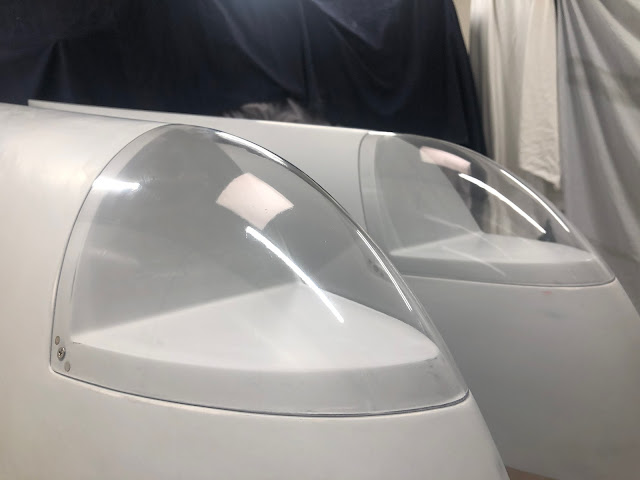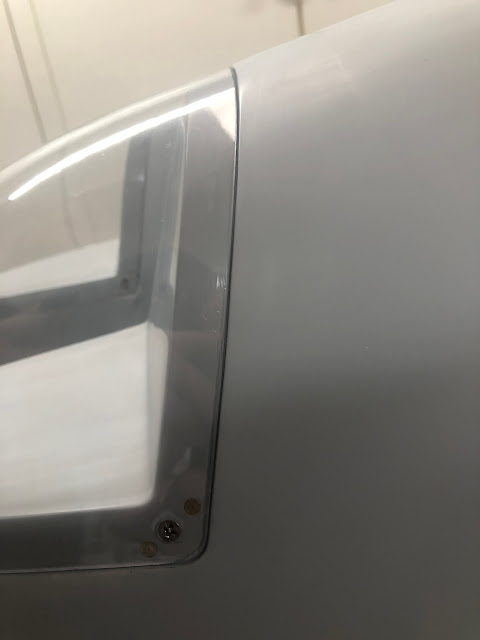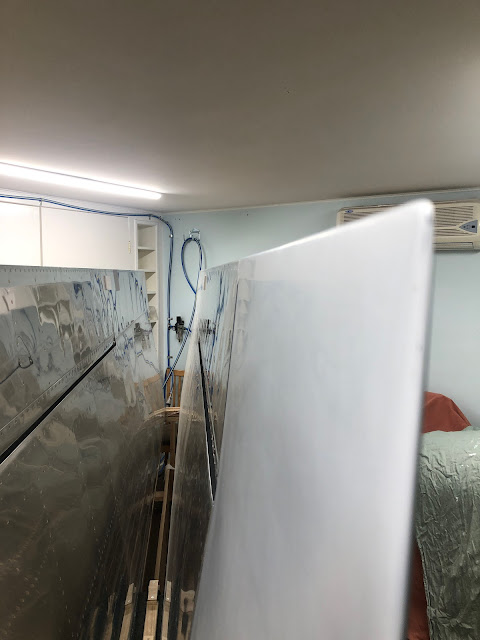The Finishing Process - step by step
To finish off the wingtips, i needed to cover over all of the micro and the remaining wingtip surface with something which would sand to a smooth finish. I could just use a primer, however the micro is made up of tiny glass spheres suspended in the epoxy - when you sand it, you cut these spheres in half and you end up with millions of tiny pinholes, which need to be filled.
There are a couple of options - paint with a primer and then use a pin-hole filler (such as blade putty) to fill all the pinholes, or do a 'skim coat' of plain epoxy. I had previously debated not doing an epoxy skim coat, and decided it really helped to reduce the number of pin-holes you end up with.
So the process is as follows:
- Rolled on a 'neat' coat of epoxy which had been thinned with acetone. I used a foam roller which i could toss at the end, and popped as many of the tiny bubbles as i could using a propane blowtorch. After the epoxy is cured, used hot soapy water to wash off any waxy bloom - you can't sand them with the bloom present.
- Gently wet sanded using 180 grit. The aim here is to just take off any lumps and bumps or runs, and scuff up the whole surface to take the primer. If you try and block the surface flat at this stage, you will just sand through the epoxy and you are back to where you started.
- Once sanded, added a coat of primer. This is to start to fill the low spots and sanding scratches, but mostly to find any pinholes or other anomalies which need to be filled.
- Once the primer has cured, fill all these pinholes etc using blade putty.
- Once the blade putty was dry, wet sanded the blade putty almost all off using 180 grit. Gave the whole surface a sand with 180 grit. Again, not trying to block it flat, but just smooth out any primer runs etc and provide a scuffed surface for the next coat of primer. After each sanding the wingtips were washed, then dried and cleaned with isopropyl alcohol. Where i sanded through the primer, i stopped sanding.
- Sprayed a second coat of primer. Once cured, this was sanded all over with 400 grit. I started to try and block down any shiny spots at this point, and was careful to stop sanding if i saw that the primer was being removed. Washed, dried and cleaned with iso after.
- Sprayed a 3rd and final coat of primer - fairly thick. This time i sanded with 400 grit all over, then washed cleaned and dried. After the initial sand, i was able to look for any low (shiny) spots and block these flat - wiping down with a wet rag, then drying with a clean rag. I continued with the 400 until the whole surface had been blocked down, there were no areas that were at all shiny (it was a consistent dull matt sheen in a low angle light) and there were no areas where i had sanded through the primer.
- Once this was done, i gave an overall sand to 800 grit. Then washed, cleaned and dried. Then checked using a low angle light any areas where the 400 sanding scratches were not sanded out, then blocked these.
- That's it! Install the landing light lenses, and pop the wingtips on the wings. Wing Kit Done!
So that is the general process - here are some photos showing how it went.
 |
| Cleaned ready for the next coat of primer |
6. 2nd Coat of Primer, block sanding with 400 grit
No photos! (boring!)
7-8. 3rd coat of primer, sanding with 400 then 800 grit.
 |
| Initial sanding with 400 grit. Following this, it was washed, cleaned and dried ready for the second round of sanding (blocking flat). |
 |
| This is a little hard to see, but you can just see some shiny spots. There were the areas which needed to be blocked some more to be flat. By drying the surface these could be seen - i then wet sanded them, cleaned locally with a wet rag, and dried locally with another clean dry rag. I then checked again. Eventually, the whole wingtip was blocked using this method with using 400. |
 |
| Lots of sandpaper! |
 |
| The wingtips sanded to 800 and drying. |
9. Installing the landing light lenses
I elected not to install the nutplates for the landing light lenses until after all the sanding was done, as these may have gotten wet and gunked up with residue. So once the sanding was done, i drilled out the hole for the screw to #27, then countersunk the nutplate attach rivet holes using the permagrit 100 degree tool. I then managed to balance the wingtips enough to set the rivets using the DRDT2 tool - i know the tool is not designed to rivet, but i didn't want to use the rivet gun on the soft fibreglass just for nutplate attach rivets. The nutplates were installed, setting the rivets a little less than usual, then the lenses installed and the wingtips finally installed on the wings.
 |
| The DRDT2 was screwed down so i could hang it off the bench to get access into the wingtips. |
 |
| I blocked up the lower die to allow me to reach the top nutplate rivets - without the washers the curve was too much in the top of the wingtip and i could not get a good angle. |
 |
| With a fair bit of balancing, and the use of my ironing board 'bench' i was able to get the reach and correct angles to set the rivets. I used a ground down flat die on the top, so miss the landing light lens 'joggle'. |
 |
| 3 or 4 hands would make building so much easier. |
And here is the installed lenses - i am happy i took the time to add the micro and refine the interface of these lenses to the wingtip. They look semi-professional in my opinion. One of those satisfying builder moments which makes this so enjoyable an undertaking.
Finishing up the Wing Kit!
 |
| A piece of PVC tube was added to protect the antenna and stabilise it inside the wingtip. I may need a larger piece of tube - we will see later on. |
The wingtips were installed using the hinge pins, and secured using a pan head screw.
Here are some photos showing the paint gap between the wingtips and the skins:
 |
| Happiness is an even gap. |
The final job was to install the access panels into the bottom of the wings, including connecting the springs to the
electric aileron trim unit and plugging it in, and placing the
magnetometer shelf in position for safe keeping. Where the access panels will need to be open later (such as at the bellcranks, or to install the magnetometer) i just used 4 screws, and left a little bag hanging out with the remaining screws for that panel.
 |
| I used cable ties connected a couple of rings down each spring to pull the springs together. |
 |
| Which made it easier to connect to the motor arm. I then clipped the cable ties off making sure i didn't leave any in the wing bay. |
 |
| I used some boelube on the flanges of the slide in ADAHRS shelf so the primer didn't stick (seize) over time. |
 |
| Some old empennage parts were moved around... |
 |
| ...and everything placed into 'storage' in order to move onto the fuselage kit. |
Some Wing Kit Stats
Overall i spent 524 hours working on the wing kit over 2 years, 6 months and 16 days. I shot 9,113 rivets, to bring the total at the end of the wing kit to 13,997.
Sadly, of the 928 calendar days elapsed, i only managed to get into the shed on 268 of them, spending an average of 1.8 hours per day worked.
I need to pull my socks up!





































































No comments:
Post a Comment